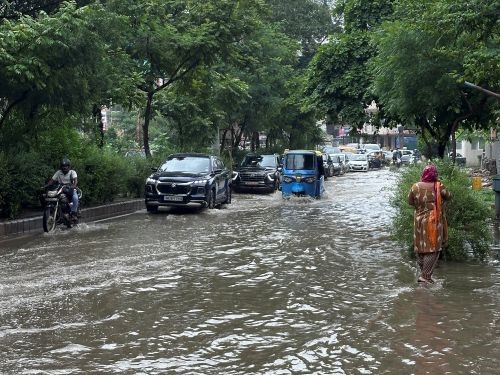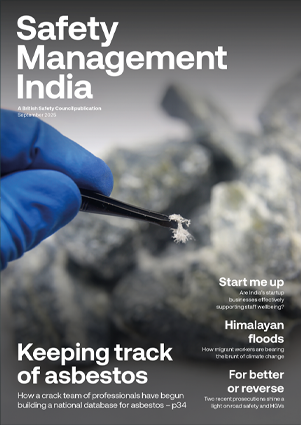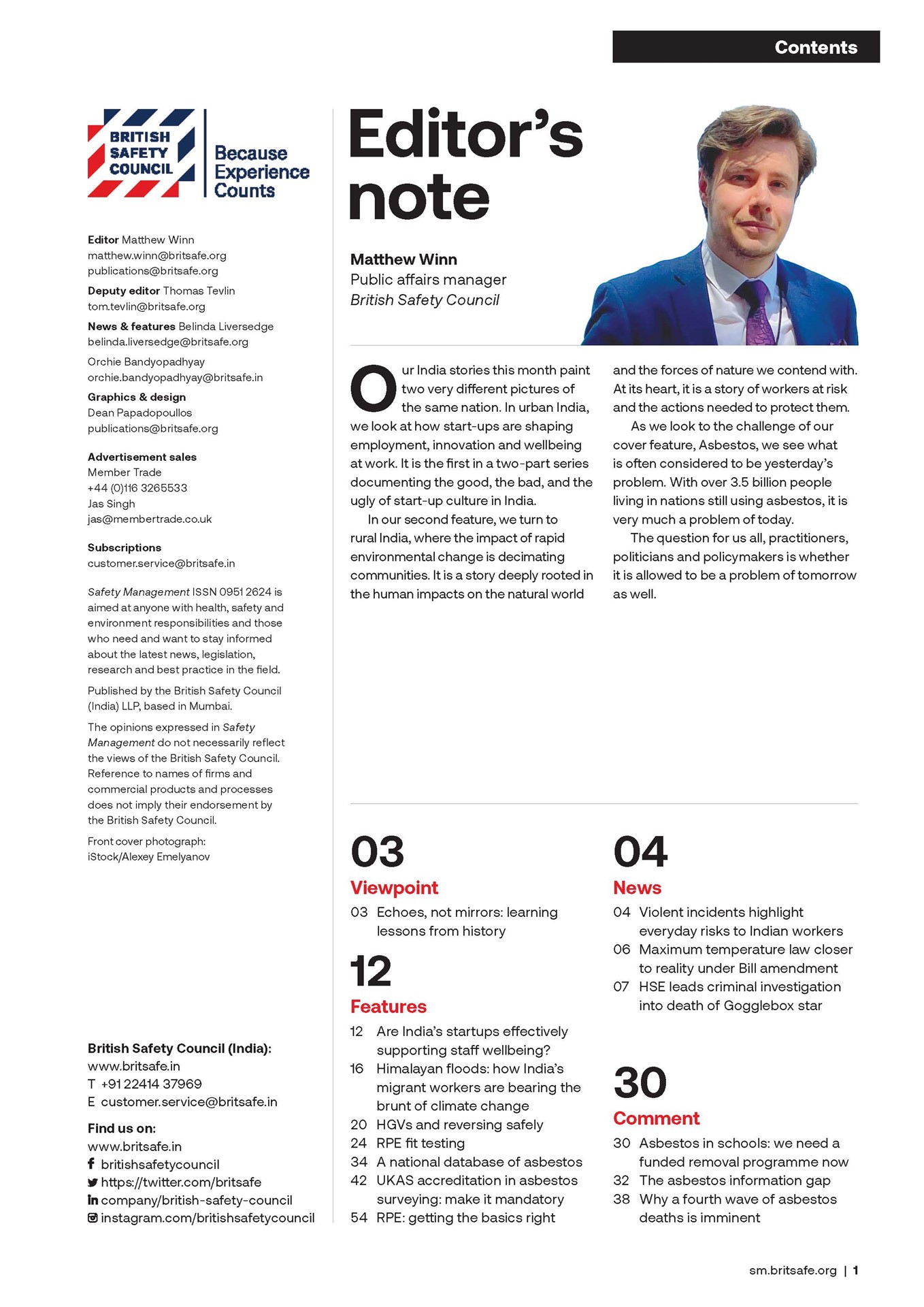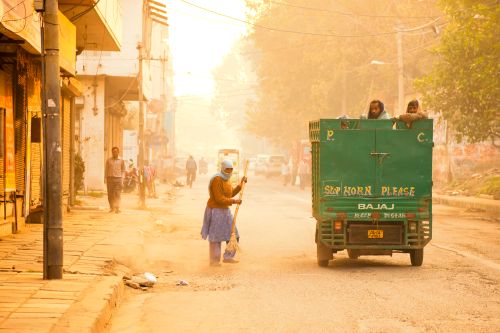India’s technology hub cities like Bengaluru and Hyderabad are increasingly suffering severe flooding, and climate experts say urgent action is now required to reverse extensive construction over natural water-absorbing landscape features to protect people and businesses.
Features
Flash flooding at India’s technology cities: a tale of unbridled development and climate change
When torrential rainstorms recently struck India’s information technology (IT) hub cities Bengaluru and Hyderabad, and emerging ones like Kolkata, social media brimmed with viral images of roads turned into rivers, submerged cars, commuters stranded at underpasses and office workers wading through waist-deep water.
In Kolkata, IT professionals from Tata Consultancy Services and Wipro were forced to trudge through waist-deep water to get to work and return home. A viral video, entitled ‘corporate mazdoor’ (‘corporate labour’), showed Wipro employees walking out of their offices through flooded streets with umbrellas in hand. “Thank God they are carrying umbrellas, otherwise they would have gotten drenched,” one Instagram
user quipped.
In Bengaluru, a photograph of ankle-deep water inside an entrepreneur’s car went viral, while another video captured commuters struggling at the Panathur railway underbridge. “My road to office,” wrote a senior executive who shared the clip, echoing the frustrations of countless workers battling the city’s battered infrastructure. In the residential district HSR Layout (Hosur Sarjapura Road Layout), residents joked bitterly that their neighbourhood had turned into ‘HSR Lake’.

Little surprise
For technology worker Sumana Ganguly, who moved to Bengaluru from Kolkata a decade ago, the disaster came as little surprise. “We’ve built on top of lakes, we’ve narrowed drains, and then we act surprised when the city drowns,” she said, pointing to water stains still marking the wall of the compound where she works.
Bengaluru is perched 3,000 feet above sea level and is famed for its pleasant climate. However, it floods almost every monsoon season. Experts trace this paradox to decades of unplanned urban development following the city’s IT industry boom that began in the 1990s.
Once a city of interlinked lakes and wetlands, these natural absorbers of rainwater have gradually been lost as they were drained so office parks for the IT industry, bus stations, residential layouts and flyovers could be built on the land. Natural rainwater ‘sponges’ were paved over and stormwater drains were narrowed or encroached upon. As a result, today, when the skies open up, the rain has nowhere to go. According to district data, 730 of Bengaluru urban district’s 837 lakes have been encroached by buildings and concrete surfaces, leaving little space for rainwater to drain.
Experts argue that the increasingly severe flooding in cities such as Bengaluru is no longer solely the result of heavy monsoon rainfall, but is being aggravated by climate change and reckless urbanisation. “A few hours of rain, and many parts of Bengaluru are flooded yet again,” wrote Harini Nagendra, director of the School of Climate Change and Sustainability at Azim Premji University in an opinion column for the Deccan Herald newspaper. “This is the current state of Bengaluru, the 21st century IT capital of India. The causes? Ill-planned urbanisation, compounded by climate change – and a city whose planners continue to favour built infrastructure over ecological infrastructure, unwilling to understand the urgency and criticality of the scenario in which Bengaluru finds itself.”
He added: “Climate change is already here, and is going to get much worse. The flooding we see is just a fraction of what we can expect in the future. When will the city’s ecological infrastructure get the prominence it deserves?”
Extreme rainfall
Climate and urban planning experts add that the city of Hyderabad in Telangana has also lost its natural buffers to extreme rainfall. Once home to over 3,000 lakes, most have been lost to encroachment by buildings and settlements, sewage inflow and garbage dumping.
“Even two centimetres of rainfall now causes waterlogging,” said Telangana’s chief minister A. Revanth Reddy in a statement this September, while calling for public support for the state Government’s Musi Riverfront Development Project, which aims to revive dried-up sections of the Musi River and in turn improve Hyderabad’s flood-resilience.
“The Musi turned into a dump yard due to neglect by previous governments,” said Reddy after inaugurating the restored Batukamma Kunta Lake at Amberpet. He stated that just one hour of rain was now causing serious flooding in areas of land in the Musi catchment area.
Telangana’s state government has now instructed the Hyderabad Disaster Response and Asset Protection Agency (HYDRAA) to take appropriate steps to protect water bodies and clear encroachments of temporary housing, shops and workshops that have been erected on green space next to rivers and lakes and on top of stormwater drains. Experts say these have reduced the capacity of the ground and storm drains to convey rainwater away and reduce local flooding. HYDRAA recently restored six lakes, including Bathukamma Kunta, in a bid to increase the ability of the natural landscape to absorb rainwater.
The Musi Riverfront Development Project aims to improve the ecological, social and economic features of the Musi riverfront through various development activities along its 55-kilometre length. Large sections of the river within Hyderabad city have largely dried up, due to factors such as construction of buildings and temporary structures along its length.
The planned measures include desilting the river to a depth of two metres to enable it to absorb and carry greater amounts of rainwater, and building flood-resilient physical infrastructure, such as flood control embankments, flood walls, flood monitoring buildings, flood-proof decks and pumping stations.
Structures along both sides of the river, such as houses, street vendor shops and kiosks, will be acquired and demolished, and a ‘green belt’ will be established along both riverbanks. This will feature green infrastructure such as permeable walkways, new trees, parks and green roofs, with the aim of absorbing rainwater that could cause flooding, while simultaneously reducing other climate impacts, such as providing shading to absorb heat from the sun.
Migration blamed for rising flood risk
Meanwhile, following severe flooding in Bengaluru in May 2025, which left three people dead, Sridhar Vembu, co-founder of the Indian multinational software company Soho Corporation, triggered controversy with a viral post suggesting rural joblessness and the resulting migration of people to work in Bengaluru were damaging the city’s fragile infrastructure. “The quality of life in Bengaluru depends on how many people we succeed in not sending from rural India,” he wrote.
The backlash was swift. Ritesh Banglani, a Bengaluru-based venture capitalist, shot back on X: “This overcrowding theory is a dangerous Gandhian fantasy. Migration is not the problem. Poor governance is.”
Others accused Vembu of scapegoating migrants, many of whom form the backbone of the city’s construction, domestic and gig economy workforce.
“It is misleading to lay the blame on people moving to the city,” argued an environmental activist. “The floods are less about population numbers and more about where and how we build.”
He added: “Bengaluru’s original planners created a system of lakes that absorbed excess rainfall. Over decades, we’ve encroached upon these spaces and broken those connections. That is why even a day of heavy rain now paralyses the city.”
When questioned, migrants like stonemason Mahesh Yadav from Bihar reject the idea their arrival in the city, including their need for housing, is to blame for Bengaluru’s flooding problems. “Back in my village, there is no steady work,” he said, standing outside a construction site in Bellandur, a suburb in south-east Bangalore. “Here, at least I earn enough to send money home. Without migrants, who will build these buildings?”
Bengaluru has always been a city of migrants. When Kempe Gowda I, the city’s visionary founder, laid its foundations in 1537, he began with a call to migrants to move to the newly established city to enable it to flourish. Traders, weavers, blacksmiths and other craftsmen were invited to make the new city their home.
Today, Bengaluru is one of the most cosmopolitan, multi-ethnic and multi-lingual cities in the country, and its population has rapidly expanded from three million to over 14 million in just three decades. Nearly half of the city’s residents are migrants, according to estimates. The rapid population growth has fuelled huge demand for housing, pushing poorer families into precarious low quality, temporary-style housing on lakebeds and storm drains, which are the very locations most vulnerable to flooding.
On the social media platform Reddit, a viral post entitled ‘De-saturate Bengaluru’ summed up the growing discontent of some of the city’s inhabitants, who argue that unchecked migration and urban expansion are imposing intolerable pressure on the city’s infrastructure, housing supply and ability to deal with excessive rainwater during monsoon season and other extreme weather events.
The user, reflecting on decades of Bengaluru’s growth, wrote that while they once celebrated the opening of big IT offices in the city, they now feel happier when companies set up branches elsewhere.
“The city’s population has already crossed 1.4 crore (14 million), up from 30 lakh (3 million) in just 30 years,” the post read. “The result is: more traffic jams, more migrants, more everyday chaos, more complaints, scarcity of water and electricity, bad air quality, declining quality of life.”
The user called for a ‘de-saturation’ of Bengaluru, saying a more balanced national approach to growth would be to encourage businesses to open in other cities, particularly so-called ‘Tier-2’ cities, which are defined as urban centres with a population below 100,000. “Let Bengaluru breathe. Let other cities grow,” the individual wrote.
The post struck a chord with many Bengaluru residents, who shared their own experiences and frustrations. One poster on Reddit wrote: “Natives always suffer. Ask Goans, Delhites, Kolkata, Mumbai. Most Tier-2 cities seem underutilised. Both migrants and natives suffer a lot. Hope more companies open up in north Karnataka. It would literally cut down Bangalore’s (Bengaluru’s) population.”
Concerns about slow official response
The frequency and severity of flooding in Bengaluru – and concerns about the slow response of the city authorities and Karnataka State Government to mitigate the risk to homes, commercial buildings and human life – are also influencing the decisions of those seeking to purchase homes in the city. Homebuyers, instead of focusing solely on factors like the quality of amenities like schools and doctors’ surgeries, the property’s resale value or the reputation of the company that built the housing, are now asking a more critical question: does the area flood?
“In areas near lakes, particularly in Sarjapur and the eastern parts of the city, flooding has become a serious issue,” said one property expert. “Homebuyers are definitely more cautious and discerning now.”
Urban flooding is not only an inconvenience to daily life; it threatens lives, livelihoods and public health. Floodwaters often become contaminated with sewage, increasing the risk of spreading potentially fatal diseases such as cholera and dengue. Flood-induced road closures, traffic jams and road damage, power outages and damage to commercial establishments cost the economy billions of rupees.
During the major floods in Bengaluru in May this year, a female worker at a software company was killed when the wall of the company’s compound in one of the major technology districts collapsed. Severe flooding of roads in the city also forced many IT companies to order staff to work from home, with a resulting negative impact on business productivity.
As well as the impact of physical damage from recent floods, residents live in constant fear of the next occurrence. “We know it’s coming,” said Bengaluru-based tech worker Sumana Ganguly. “The question is whether the city will finally fix its drains and protect its lakes, or whether we’ll keep blaming each other.”
Shrinkage of natural waterbodies
Satellite studies show a dramatic shrinkage in Bengaluru’s natural waterbodies, like lakes and wetlands, and green cover, replaced by concrete surfaces that accelerate rainwater runoff. In a number of locations, stormwater drains have become narrower due to encroachments by the construction of buildings and temporary structures like makeshift shops and low-quality housing for people on low incomes, and the stormwater drains are often clogged with debris in the form of liquid and solid waste, further reducing their ability to convey rainwater. As a result, even moderate rainfall regularly overwhelms neighbourhoods, causing frequent and sometimes severe flooding.
Writing for The Hindu newspaper, Hymavathy P, senior research associate, and Priyanka Jamwal, programme leader and senior fellow at the Ashoka Trust for Research in Ecology and the Environment’s (ATREE’s) Water, Land and Society Programme, argue that cities like Bengaluru need to focus on ways of absorbing rainwater, rather than merely directing it into stormwater drains, which often quickly become overwhelmed, leading to flooding. They argue the city’s authorities and the Karnataka Government should take approaches such as increasing the water-holding capacities of waterways by removing structures built over them, and providing soakaway areas like green planting to absorb rainwater.
Climate change impacts
However, climate experts say that climate change impacts – such as heavier, more intense and more frequent spells of rainfall – threaten to exacerbate flooding in cities like Bengaluru and Hyderabad in the future. For instance, on 23 September Kolkata city in West Bengal witnessed its heaviest rainfall in nearly 40 years as a relentless downpour hit the city, flooding large parts and leaving around 10 people dead. Scientists warn that extreme rainfall events are becoming more frequent in regions of India located near the oceans.
Roxy Mathew Koll, climate scientist at the Indian Institute of Tropical Meteorology, warns that sea surface temperatures in the Indian Ocean are projected to remain above 28°C throughout the year by the end of this century. “These conditions are highly conducive for extreme rainfall and cyclone formation,” he says. “The number of severe cyclones and heavy rainfall events has already gone up since the 1950s and will increase further as ocean temperatures climb.”
The Indian Ocean’s warming has been identified as the single largest contributor to the global rise in sea surface temperatures. Researchers predict that marine heatwaves in the Indian Ocean could jump from about 20 days a year to nearly 250 days annually, pushing the ocean into a near-permanent heatwave state. This would not only intensify storms – bringing even more intense rainfall to cities like Bengaluru, Kolkata and Hyderabad – but also devastate marine ecosystems through coral bleaching and seagrass loss.
Climate and weather experts warn that the extreme rainfall event in Kolkata on 23 September might not be a one-off disaster but a preview of what lies ahead as warming seas continue to reshape the strength and extent of monsoon season and amplify extreme weather across the region.
As Bengaluru picks up the pieces after yet another catastrophic flood, the larger lesson is clear: blaming migrants won’t keep the waters out. Without urgent investment in drainage, lake restoration and climate-resilient planning, India’s tech capital will remain as vulnerable as ever, no matter how many people live there.


FEATURES

Delhi’s air pollution problem leaves construction workers jobless and without pay
By Orchie Bandyopadhyay on 10 November 2025
Every autumn and winter, Delhi experiences terrible air pollution that places the health of its 40 million residents at grave risk. But government measures to alleviate the problem by temporarily closing construction sites mean hundreds of thousands of daily-wage labourers are being left without wages and a means of financial support.

India’s road rage crisis: how professional drivers are bearing the brunt
By Orchie Bandyopadhyay on 10 November 2025
High profile reports of violent attacks on people who drive for work purposes, like bus and delivery drivers, have shone a spotlight on the growing problem of road rage in India. Commentators say it is now time for the Government to step up prosecutions of those who act aggressively on the road, while educating drivers on stress management techniques, to tackle the problem.

